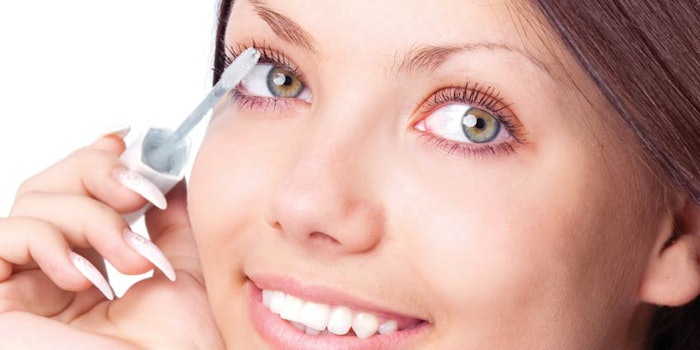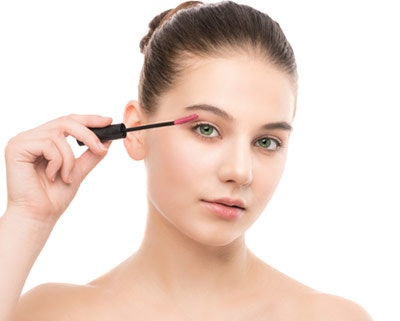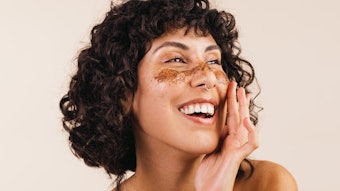
Where would we be without eyelashes, the small hairs on the eyelid that offer the eye a veil of protection and give any look a boost of glam? To be lacking them is an eliminated option for lash lovers. The lash has been long adorned with mascara and graduated to lash tints, lifts and extensions. While extensions may be a hot trend, it’s not the best option for everybody. The barriers that exist for a client that covets long lashes include access to a lash stylist, cost and the ability to wear extensions due to allergens or ocular conditions. Thankfully, an alternative trend has erupted on the scene to rescue all those who covet long lashes in the form of lash growth serums.
Lash Lifecycle
The cycle of an eyelash occurs over approximately five months. In that time, the lash goes through three developing phases: anagen, catagen and telogen.
Anagen. The anagen phase is when the lash is growing via presence of stem cells and keratinocytes in the follicle. This cycle lasts between 30-45 days. At any given time, about 40% of one’s upper lashes are in the anagen phase.
Catagen. The catagen phase occurs over two weeks when lashes are in transition. The lash has reached its full length, and the hair follicle begins to shrink.
Telogen. During the telogen phase, lashes are at rest before falling out. This phase usually occurs over three months, but it can last for as long as nine.1
Discussing the lifecycle of a lash with your client will help them understand why a lash serum “doesn’t last” after a couple of months if use is discontinued. Remember, not all lashes are at the same phase at the same time. Allowing only short breaks or a continuous application is necessary for a more permanent effect. Untreated lashes will only grow to their natural length as they did before.
Don’t DIY Lash Serums
A popular organic alternative is the application of castor oil to the eyes. While people report longer lashes from the use of castor oil, the fatty acid oil does not gain the support of lash experts, dermatologists or ophthalmologists. These sources say there is no data to support the claim that it improves lash length, and they also warn against applying anything to the eye that is not specifically formulated for the eye. The speculation is that the glossy appearance of oil on the lash gives the illusion of a longer, healthier lash. The same goes for other trends such as coconut oil or emu oil. For an effective lash growth serum, it’s best to stick to products that have been tested to be safe for use on the eye and even better if they provide clinical studies.
Lash Ingredients
When choosing a lash growth serum for you or for your clients, it is advised to choose a line that makes their ingredient list readily available. Discussed here are lash ingredients that have seen success.
Peptides. Peptides are commonly found in serum formulations and can be very effective. Specifically, myristoyl pentapeptide-17 boosts keratin production by increasing keratin gene expression by 160%.1 Studies showed that participants had noticeable results after six weeks without any adverse side effects.

Amino acids. Some lash serums use amino acids such as arginine to improve lash length and condition. Since lashes are made up primarily of protein, it makes sense to formulate a product with amino acids, which are the building blocks of proteins. This allows the lash to be stronger and thicker to yield positive results.
Prostaglandin. Prostaglandin is effective in inducing the anagen phase of a lash as well as promoting growth of the hair bulb size in the dermal papilla. Prescription strength prostaglandin analogs such as latanoprost, bimatoprost and travoprost are used in the treatment of glaucoma. In fact, it was through the treatment of glaucoma that Latisse (bimatoprost) was first created as a prescription lash grown serum in 2008.2
While it may be the heavy hitter for results, prostaglandin should be chosen for use with full disclosure. Prostaglandin is an ingredient that in extremely rare cases can cause permanent discoloration of the iris. It may also cause acute irritation, inflammation or pigmentation around the eye. Pigmentation around the eye and irritation are reversed upon cessation. Prostaglandin is a naturally occurring compound in tissues with the function of uterine contractions. For this reason, it has not been deemed safe for testing of use in pregnant women. Because risk cannot be ruled out due to lack of testing, it’s not safe for use in breastfeeding women or those undergoing chemotherapy.
Synthetic prostaglandin. With the success of prostaglandin for lash growth, other companies indulged in the lash craze and created comparable retail products. Retail serums containing synthetic versions of prostaglandin may be less effective; the results are more varied among different individuals. However, retail formulations containing prostaglandin have never been reported for affecting the iris color among users. One example is cloprostenol isopropyl ester, a synthetic analog of prostaglandin. It has shown irritation in very few cases, which often resolves itself. Both traditional and synthetic prostaglandin are found to have a significant effect on lash growth, and there are many options to try.
Biotin. Biotin is a vitamin that encourages hair growth by increasing blood flow to hair follicles. It also has a hand in improving the condition of hair by preventing it from drying and falling out. Some lash serums claim positive lash results with biotin while others believe taking the supplement alone boosts their eyelashes. However, studies conclude there is limited evidence demonstrating the effect of biotin on hair growth.3
Application and Maintenance
All lash serums should be applied daily on the upper lash line. While it can be applied to the lower lashes, it may increase the risk of irritation or getting the product in the eye. Another effect may be purple discoloration on the lids where the serum is applied, which may look okay on the top but will produce an undesirable effect on the lower lash line. Full results are achieved in approximately three months. Continuous wear will ensure new lashes are treated, and results are maintained.
To prevent premature lash loss, it is imperative to remove mascara nightly and to avoid wearing waterproof formulas.2 Skipping this creates a hard shell around the lash, making it more likely to break off. Other factors that may affect lash length and longevity are systemic illness, hormonal changes and ultraviolet radiation in relation to age. The outcome is thinner and shorter lashes that may appear lighter or sparse. To assist in the growth phase and maintenance of longer lashes, lash growth serums have the best results for obtaining long, natural lashes.
A Profitable Product
Users of lash serums report high satisfaction as well as a dramatic boost in confidence. This makes it a money-maker in your spa. Lash serums may prove to be the fastest and easiest product you sell in your business. It is best to carry the line a month or two after personal use, allowing you to be the walking-talking advertisement of its effectiveness. Many users report not being able to go back to “not having lashes.” Like wildfire, the demand can spread to the friends and family of your clients, and you may even have a hard time staying stocked. Having beautiful lashes for yourself and your clients and a profitable product for your business is just another benefit to those small hairs that protect the eye and boost glam.












